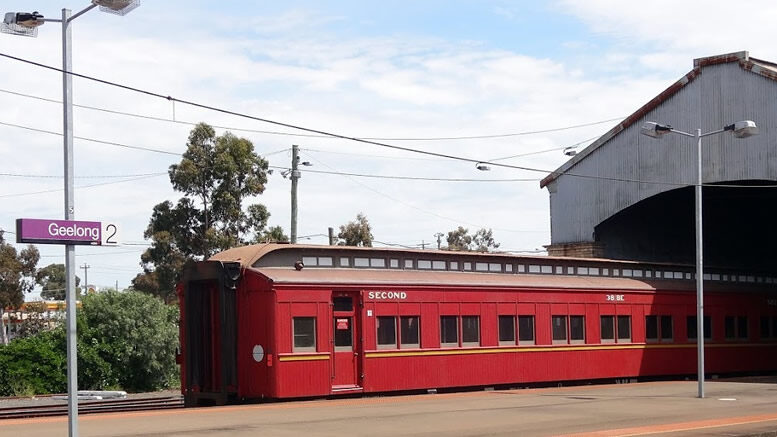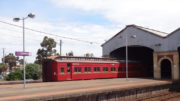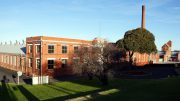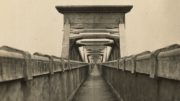Geelong has been long been teased with of the dream of fast rail services by both State and Federal parties for decades. Barely an election is called without a grand pork barrelling plan being announced to explore a fast train service with little more than a few feasibility studies and still a regular service that can take around the same time between Geelong and Melbourne as it did in back in 1950.
Back in the early 1950s the then Victorian Minister for Transport announced an hourly train service to Melbourne via new 70mph trains running on duplicated and electrified tracks. The work to duplicate the tracks was expected to be ready three years before electrification in 1955. The Minister was quoted as saying that the works would not be delayed.
Eventually the track from Geelong to Melbourne was duplicated starting with North Geelong to Corio in 1959, Werribee to Little River in 1970 and finally through Lara in 1981. Electrification however only reached as far as Werribee in 1983. Considering both the then Transport Minister Edward Guye and then Premier Tom Hollway were both long dead before some promises were met, as I read about the current round of fast train proposals I am reminded of the old proverb fool me once, shame on you, fool me twice, shame on me.
Moving on to the year 1999 and soon to be Premier Steve Bracks promises regional fast rail with 29 new V/Line trains to be known as the VLocity 160 that would reduce the Geelong to Melbourne commute time to 45min thanks to these speedy new trains travelling along at 160kph on upgraded tracks. While the new trains were introduced as promised but slightly delayed in late 2005, the 45min target was soon revised to 49min and only on one express service each day. It seems that the time savings were only achieved mostly but cutting out stopping at stations. Eventually this express service was dropped.
By 2008 the Regional Rail Link idea emerged as part of the Victorian Transport Plan. Starting with two new platforms at Southern Cross Station, the $4.3 billion joint federal and state government project was announced by Anthony Albanese and John Brumby as a way to “untangle” the V/line and metro lines and provide “more trains, more often”. Geelong’s trains would now travel around Werribee via Deer Park and Sunshine and provide two new stations at the growing suburbs of Tarneit and Wyndham Vale. Despite the longer route it was announced that the travel time were going to be maintained thanks to not getting held up by metro services and the high speed track that would be devoid of level crossings between the West Werribee Junction and Deer Park. The 1999 promise of 45 min trains is never mentioned again.
In 2011 the incoming Liberal leader Ted Baillieu puts a hold on the already underway rail link while it gets reviewed. The Victorian Transport Plan also gets the chop despite $6 million of marketing being spent on it in the lead up to the election. The new Liberal government claims the project is a screw up and will cost in excess of 5 billion dollars and that Labor used the back of an envelope to calculate the cost. Eventually work resumes on a revised Rail Link that removes some parts of the project in a cost-cutting exercise, most notably the link from Wyndham Vale to Werribee. Ted also went to the election with the promise of returning trains to the Geelong, Ballarat and Bendigo lines as well as kick-starting the Avalon Airport rail line but in reality these were just feasibility studies that came to the conclusion that the project was not yet feasible.
By the 2014 election the Regional Rail Link is almost complete, the Liberal government states it is ahead of schedule and will now cost 4.1 billion dollars. A $15 million Moving Victoria marketing plan shows off how it’s only a project that The Liberals could deliver along with a slightly different version of the metro tunnel that was part of the previous Victorian Transport Plan. Now known as the Melbourne Rail Link this new tunnel was to avoid the Melbourne CBD.
Eventually the regional rail link gets opened by the new Andrews Government in June 2015 but 2 months behind schedule who blames the former government for forgetting to order the trains. The eventual cost to build the project came in at $3.65 billion and despite the savings, no further funds are allocated to finish the missing link to Werribee. The Metro tunnel project reverts to the 2008 plan under Swanston Street.
The new link is hailed by the new government as a great success that would not have been delivered without Labor funding it. While there were a lot more trains running more frequently, patronage on the line grew almost 60 per cent in the first year. This was thanks to the line now being a quasi-metro service for the growing suburbs of Tarneit and Wyndham Vale. Soon some peak services saw standing room only as well as travel times blow out on some services thanks to a go slow on the curved North Melbourne flyover that is blamed on prematurely worn wheels.
During the 2018 Victorian state election, glossy brochures and videos are made to show off the future plans of a suburban rail loop around Melbourne, a link to Melbourne Airport which all ties up with a plan to duplicate tracks to Wyndham Vale and completing the suburban loop to Werribee. The benefits to Geelong are that trains will now run faster on the new track shared with the airport rail from the Sunshine super stop to the Melbourne CBD and the possibility of speed improvements of greater than 160km/h via new electric trains. The brochure is filled with words like potential, exploration and identify options, the brochure also ends with the next step is a business case. The timeline to completion of this potential project is vague too, but the government also stated any improvement would not be able to happen until after the airport rail link is finished. A project that will start in 2022 and take 9 years to complete.
Seeing that rail projects are a vote winner the Liberals put up a proposal for the 2019 Federal election with pictures of a fast looking train (which is actually a QLD tilt train that is capable of 160km/h just like our current V/locity trains) and “2 Billion dollars delivered” quotes. This plan is quoting a 32-min journey between Geelong and Melbourne thanks to “travelling at the fastest speeds of any train line in the nation at an average of 160 km/h” which will be the “first of its kind in Australia”. Some people are critical that $2 billion would have not been enough to fund the project, even if matched by the state. Both this plan and the states plan were to rely on the airport rail link to Sunshine that is part of a new line that was already funded at a cost of $10 Billion. Interestingly at the 2018 state election the Liberal opposition also were pushing a 32min plan to Geelong, but were then quoting the need of a 200 km/h European style high speed train.
Fast-forward to a late 2020 state budget that is filled with stimulus funding thanks to the Covid-19 pandemic and a plan is relieved as to where the joint promised $4 billion will go. Talk of duplicating the Wyndham Vale line is dropped (possibly due to the realisation that the road overpasses were short-sightly not built wide enough to fit 2 extra tracks under them) in favour of 12 kilometres of new track between Werribee and Laverton. This new route, which is a revival of the pre-2015 route, will see Geelong trains run at around 50 minutes to Melbourne on some services. Future upgrades are quoting that this time will see this time drop to around 40 minutes. Not exactly the 32 minutes promised at the election but a welcome improvement anyway. It is suspected that the government may be planning to shave off the extra 10 minutes in the future by building Metro 2, a long suggested but never committed to plan to build a tunnel between Newport to Clifton Hill via Fisherman’s Bend, Southern Cross and Parkville.
Summing up, both parties are guilty of making election promises that may not start in their upcoming term or even the term after that, and even when the job does get pulled off it can quite often not be as good as what was expected. We are sure there will be a faster train one day as there are plenty of small improvements that can be made that will all add up to shaving some time off. We just won’t be expecting to hop on a super-fast bullet train any time soon.





